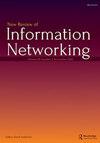前向纠错码中空间相关性的影响研究
Q2 Social Sciences
引用次数: 1
摘要
摘要:多输入多输出-正交频分复用(MIMO-OFDM)因其在增强空间分集增益、可靠性和空间复用增益方面的性能而迅速受到欢迎。本文讨论了空间相关性在MIMO-OFDM系统前向纠错中的作用。这里,在瑞利、Rician和加性高斯白噪声(AWGN)三个信道模型下验证了四种纠错码,即卷积码(CC)、低密度奇偶校验码(LDPC-CC)和里德-所罗门码(RSC-CC)。使用四种调制方案进行分析,如正交相移键控(QPSK)、二进制相移键控制(BPSK)、正交幅度调制(QAM)-16和QAM-64。它在三种天线配置下执行,如2×2、2×4和4×4。此外,利用峰值信噪比(PSNR)来识别图像传输,以及利用误码率(BER)来识别数据传输。实验结果表明,Turbo CC具有较好的性能。本文章由计算机程序翻译,如有差异,请以英文原文为准。
Examining Impacts of Spatial Correlation in Forward Error Correction Code
ABSTRACT The utilization of Multiple Input Multiple Output – Orthogonal Frequency Division Multiplexing (MIMO-OFDM) has rapidly gained popularity because of its improved performance capabilities in terms of enhanced spatial diversity gain, reliability as well as the spatial multiplexing Gain. This paper discusses the effect of spatial correlation in Forward Error Correction of MIMO-OFDM system. Here, the four error correction codes, namely, Convolutional Code (CC), Low-Density Parity Check (LDPC-CC), and Reed-Solomon code (RSC-CC) is validated under three channel models, namely, Rayleigh, Rician and Additive White Gaussian Noise (AWGN). The analysis is performed using four modulation schemes such as Quadrature Phase Shift Keying (QPSK), Binary Phase Shift Keying (BPSK), Quadrature Amplitude Modulation (QAM)-16, and QAM-64. It is performed under three antenna configurations like 2 × 2, 2 × 4, and 4 × 4. Moreover, the Peak Signal to Noise Ratio (PSNR) is exploited to identify the image transmission, as well as the Bit Error Rate (BER), is exploited to identify the data transmission. In experimental results, the Turbo-CC displays better performance.
求助全文
通过发布文献求助,成功后即可免费获取论文全文。
去求助
来源期刊

New Review of Information Networking
Social Sciences-Education
CiteScore
2.10
自引率
0.00%
发文量
2
期刊介绍:
Information networking is an enabling technology with the potential to integrate and transform information provision, communication and learning. The New Review of Information Networking, published biannually, provides an expert source on the needs and behaviour of the network user; the role of networks in teaching, learning, research and scholarly communication; the implications of networks for library and information services; the development of campus and other information strategies; the role of information publishers on the networks; policies for funding and charging for network and information services; and standards and protocols for network applications.
 求助内容:
求助内容: 应助结果提醒方式:
应助结果提醒方式:


